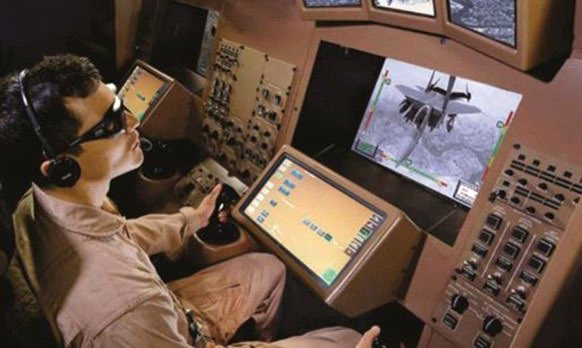AFRL/711HPW/RHBC OPERATIONAL BASED VISION ASSESSMENT LABORATORY
RVS TECHNOLOGY
- Enables Boom Operator to move from direct view of the air refuling station in tail of aircraft to the front of aircraft behind the cockpit
- RVS 2.0 uses high resolution cameras and 3D displays to provide full color, immersive imagery to allow Boom Operators to guide refueling boom and carry out refueling mission
- RVS 2.0 design fixes image washout and 3D distortions that limit performance of the KC-46 RVS 1.0 design
WHAT IS IT?
Remote Vision System (RVS) technology uses cameras, image processing and stereoscopic, or 3D, displays to provide Air Refueling Operators, or Boom Operators, with the imagery they need to carry out the refueling mission.
This technology replaces the direct view technology (i.e., looking out a window) used by the USAF in KC-135 and KC-10 tankers legacy tankers.
An RVS provides a solution to avoid cutting a hole in the aircraft fuselage for a window and associated certification issues, enables image processing and night vision capability to support covert refueling and provides the technology to enable autonomous refueling.

KC-46 Air Refueling Operator Station showing RVS 1.0 design with HD resolution, black and white cameras and 3D display.
WHY IS IT IMPORTANT?
The KC-46 RVS 1.0 design resulted in degraded air refueling performance relative to the legacy tankers. Boom operators reported physiological symptoms including eye-strain and headache during testing and they frequently struck the receiver aircraft outside the receptacle. The degraded air refueling observed during KC-46 developmental testing resulted in two Category 1 Deficiency Reports for the RVS 1.0 in 2016, delaying delivery of this critical weapons platform.
The AFRL 711 HPW/RHB OBVA Laboratory teamed with the Air Force Life Cycle Management Center (AFLCMC) and Boeing Defense to support the KC-46 RVS Tiger Team to define critical RVS design factors in 2018 and then led the KC-46 RVS Joint Technical Team (JTT) in 2020 to develop and negotiate the redesigned eRVS and RVS 2.0 at no cost to the USAF.
The redesigned RVS 2.0 provides a full color, high resolution, immersive, 3D display to optimize Boom Operator performance, maintain viewing comfort for long missions and enabled the delivery of the KC-46 while allowing easy future technology.
“Vast improvement over 1.0.”
“…it gave me a more realistic version of what I would see if I was looking out of a window.”
~ Comments to the OBVA Lab researchers and JTT from Active Duty Boom Operators participating in research evaluating a prototype of the RVS 2.0 3D display.

KC-46 refueling C-17. Air Force photos – 2016 test flight.

